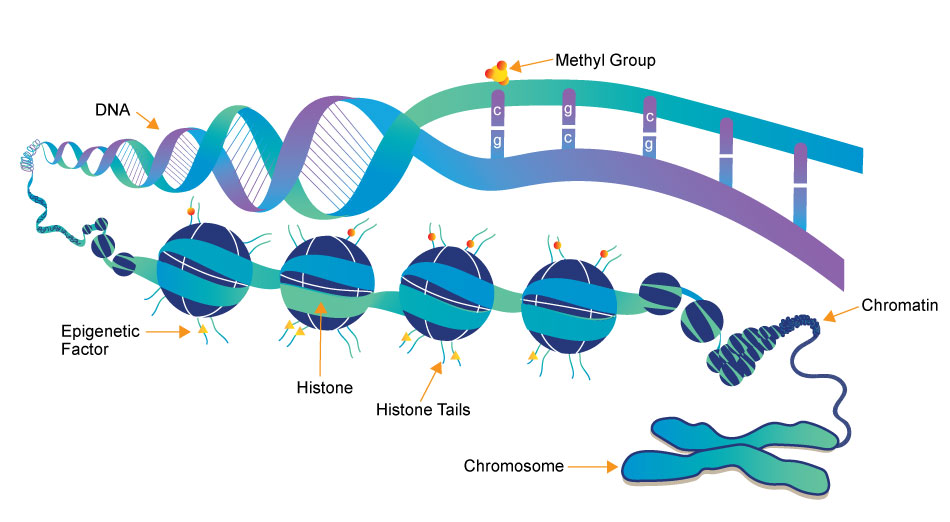Epigenetics


Epigenetics research delves into the molecular mechanisms that control gene expression and cellular traits without altering the underlying DNA sequence. One crucial aspect of this field is the role of small molecules, which act as powerful regulators of epigenetic modifications. These small compounds, typically comprising a few dozen to a few hundred atoms, have emerged as essential tools in understanding and manipulating the epigenome.
- DNA Methylation Inhibitors: Small molecules like 5-azacytidine and 5-aza-2'-deoxycytidine are DNA methyltransferase inhibitors. They block the addition of methyl groups to DNA, leading to DNA demethylation. This can reactivate silenced genes, potentially offering therapeutic avenues for conditions like cancer.
- HDAC inhibitors: HDACs remove acetyl groups from histone proteins, contributing to gene repression. Small molecule HDAC inhibitors, such as Vorinostat and Romidepsin, can reverse this process by increasing histone acetylation, allowing genes to be more accessible for transcription. These inhibitors are being explored for cancer therapy and other conditions.
- Histone Methyltransferase Inhibitors: Small molecules like GSK126 inhibit specific histone methyltransferases, affecting histone methylation patterns. This can alter gene expression, making them promising candidates for cancer and other diseases with epigenetic dysregulation.
- RNA Modulators: Small molecules can also target non-coding RNAs involved in epigenetic regulation. For instance, small molecules called small interfering RNAs (siRNAs) can be designed to target and degrade specific long non-coding RNAs, influencing gene expression.
- Epigenetic Reader Domain Inhibitors: These small molecules target proteins that recognize and bind to specific epigenetic marks. Examples include inhibitors of bromodomain-containing proteins (BET inhibitors), which can disrupt gene regulation by interfering with protein-DNA interactions.
Small molecules in epigenetics research not only provide insights into the fundamental biology of gene regulation but also hold immense promise for developing novel therapeutics. Their ability to selectively modulate specific epigenetic marks and pathways has led to ongoing clinical trials and drug development efforts for various diseases, including cancer, neurological disorders, and inflammatory conditions. Understanding and harnessing the power of these small molecules is at the forefront of modern epigenetics research, offering new hope for precision medicine and targeted therapies.
3 key components involved in the regulation of epigenetic modifications
Epigenetics Writer
Epigenetics writers are enzymes responsible for adding chemical marks or modifications to DNA or histone proteins. These marks include DNA methylation (addition of methyl groups to DNA) and histone modifications (such as acetylation, methylation, phosphorylation, etc.).
Epigenetics Reader
Function: Epigenetics readers are proteins that can recognize and bind to specific epigenetic marks on DNA or histones. These reader proteins interpret the epigenetic code and facilitate downstream cellular processes, such as gene activation or repression.
Epigenetics Eraser
Function: Epigenetics erasers are enzymes responsible for removing or reversing epigenetic marks on DNA or histones. This process allows for the dynamic regulation of gene expression and the resetting of epigenetic states during various stages of development and in response to environmental changes.
-
PKC 抑制剂
Bryostatin 1 是从海洋苔藓动物 Bugula neritina 中分离出的一种大环内酯,它调节蛋白激酶 C(PKC)的活性。Bryostatin 1 引发 PKC 的快速激活和自磷酸化,导致 PKC 酶转移到膜上。 -
PKCβ 抑制剂
LY317615(Enzastaurin)是一种强效且选择性的PKCβ抑制剂,具有抗增殖活性(IC50约为6 nM)。- Bopei Cui, .et al. , Signal Transduct Target Ther, 2023, Sep 25;8(1):366 PMID: 37743418
- Myricitrin 是 myricetin 的 3-O-rhamnoside。Myricitrin 被一些甲虫种类用于它们的交流系统。
- Ayumi Yamamoto, .et al. , Nutrients, 2022, Mar 4;14(5):1078 PMID: 35268053
-
PKC 抑制剂
Staurosporine 是一种天然产物,最初于 1977 年从细菌 Streptomyces staurosporeus 中分离出来。Staurosporine 的主要生物活性是通过阻止 ATP 与激酶结合来抑制 蛋白激酶。这是通过 Staurosporine 对激酶上的 ATP 结合位点具有更强的亲和力来实现的。- Lisa M Kim, .et al. , Cancer Res, 2022, Sep 2;82(17):3045-3057 PMID: 35792658
- Jacobs CL, .et al. , Nat Methods, 2018, Jul;15(7):523-526 PMID: 29967496
- Birte Plitzko, .et al. , J Biol Chem, 2017, Dec 22; 292(51): 21102-21116 PMID: 29074620
-
PKC 抑制剂
Verbascoside,从马缨丹(Lantana camara)中提取,作为PKC的ATP竞争性抑制剂,具有25 μM的IC50值,并具有抗肿瘤、抗炎和抗神经痛活性。 -
p32-kinase activator
D-erythro-鞘氨醇(红鞘氨醇)是一种非常有效的p32-激酶激活剂,其EC50为8μM,并且能够抑制蛋白激酶C(PKC)。D-erythro-鞘氨醇(红鞘氨醇)也是PP2A的激活剂。 -
PKC 抑制剂
Ruboxistaurin(LY333531)是一种强效、选择性的蛋白激酶C同工酶抑制剂,针对PKC β I(IC50=4.7 nM)和PKC β II(IC50=5.9 nM)具有抑制作用。 -
PKC 抑制剂
PKC 412 是一种广谱蛋白激酶抑制剂。它能抑制常规的 PKC 同型体 α/β/γ,PDFRβ,VEGFR2,Syk,Flk-1,Flt3,Cdk1/B,PKA,c-Kit,c-Fgr,c-Src,VEGFR1 和 EGFR。展示出强大的抗肿瘤活性。 -
δ-protein kinase C (δPKC) 抑制剂
Delcasertib (KAI-9803) 是一种强效且选择性的 δ-蛋白激酶C (δPKC) 抑制剂。 - Ingenol mebutate 是一种存在于植物大豆草(Euphorbia peplus) 树液中的物质,它是细胞死亡的诱导剂。
- Yao-Yu Hsieh, .et al. , Toxicol Appl Pharmacol, 2022, Aug 15;449 PMID: 35724704
-
PKC activator
(-)-Indolactam V 是一种蛋白激酶C激活剂,它强烈地将来源于人类胚胎干细胞的确定性内胚层引导成胰腺内胚层。- Manuel Mendoza, .et al. , Tetrahedron, 2019, May
- alpha-淀粉样前体蛋白调节剂是一种细胞渗透性的苯并内酯衍生的PKC激活剂(对PKCα的Ki = 11.9 nM),即使在100 nM的浓度下,也能有效增强人类成纤维细胞中淀粉样前体蛋白(APP)的非淀粉样α-加工。
-
PKC 抑制剂
GF 109203X 是一种强效且选择性的 蛋白激酶C 抑制剂,特别选择性地针对 α 和 β1 亚型(IC50 值分别为 0.0084、0.0180、0.210、0.132 和 5.8 μM,针对 α、β1、δ、ε 和 ζ 亚型)。相较于 MLCK、PKG 和 PKA 具有选择性(IC50 值分别为 0.6、4.6 和 33 μM)。在 5-HT3 受体上是一种强效拮抗剂(Ki = 29.5 nM)。 -
PKC 抑制剂
Ro 31-8220 mesylate 是一种 PKC-抑制剂,它能够抑制由 PKC-激活剂 phorbol myristate acetate(PMA,IC50 = 1.35 x 10(-6) M)或 diacylglycerols(OAG, diC8)诱导的人类中性粒细胞(PMNs)的刺激性液体胞饮作用,抑制率达到95%。- Dao-Lai Zhang, .et al. , eLife, 2018, 7: e33432 PMID: 29393851
-
PKC 抑制剂
GO6983 是一种强效的蛋白激酶C(PKC)抑制剂。它可以减少心肌缺血/再灌注损伤后的多形核白细胞粘附和浸润。- Kouki Kawakami, .et al. , Nat Commun, 2022, 13: 487 PMID: 35078997
-
PKC activator
12-O-四十碳酰基山麻杆-13-醋酸酯是山麻杆的二酯,是从巴豆油中提取的肿瘤促进化合物。它是一种可逆的、高效的蛋白激酶C(PKC)激活剂,在体外和体内的纳摩尔浓度下具有高效活性。- Ping Li, .et al. , J Ovarian Res, 2024, Sep 17;17(1):188 PMID: 39289738
- 蛋白激酶C(19-31),这种肽源自PKCa的伪底物调节域(残基19-31),在位置25的丝氨酸取代了野生型的丙氨酸,它被用作蛋白激酶C底物肽,用于测试蛋白激酶C的活性。
-
antiviral agent
Daphnoretin(Dephnoretin),从Wikstroemia indica中提取,具有抗病毒活性。Daphnoretin 类似于 PMA,可能直接激活蛋白激酶C,进而激活NADPH氧化酶并引发呼吸暴发。 -
PKCβ1 and PKCβ2 抑制剂
LY333531 是一种 β-特异性蛋白激酶C抑制剂。它竞争性地并可逆地抑制 PKCβ1 和 PKCβ2,其 IC50 值分别为 4.7 和 5.9 nM。 -
PKCθ 抑制剂
PKC-theta 抑制剂 1 是一种 PKCθ 抑制剂,其 Ki 值为 6 nM,在体内抑制 IL-2 产生,IC50 值为 0.19 μM。 -
PKC activator
Phorbol 12,13-二丁酸酯(Phorbol dibutyrate)是一种PKC激活剂并且是一种强效的皮肤肿瘤促进剂。 -
PKC 抑制剂
Ro 31-8220 是一种强效的 PKC 抑制剂,其 IC50 分别为 PKCα 5 nM、PKCβI 24 nM、PKCβII 14 nM、PKCγ 27 nM、PKCε 24 nM 和大鼠脑 PKC 23 nM。 -
PKC 抑制剂
Bisindolylmaleimide X hydrochloride(BIM-X hydrochloride)是一种强效且选择性的蛋白激酶C(PKC)抑制剂。 -
PKs 抑制剂
HA-100 是一种添加了哌嗪磺酰基的异喹啉化合物,它作为蛋白激酶(PKs)的抑制剂,包括 PKA、PKC 和 PKG(IC50 分别为 8、12 和 4 微摩尔)。




